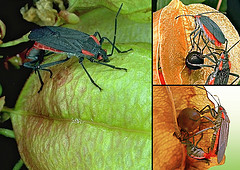Jadera haematoloma in North America

There is ongoing rapid evolution of soapberry bug mouthpart morphology in relation to the seed defense structures of its hosts. Rapid evolution in bug populations that feed on recently introduced sapinds is grounded with an ancestral pattern of coevolution between the bugs and the defenses of native sapinds.
Even in cases in which bugs have had only a few decades of exposure to nonnative hosts, beak lengths can be predicted based on the structure of that sapind's fruits; beak length is positively correlated with fruit diameter and has a genetic basis (maternal and environmental effects do not determine beak length). This pattern suggests that ongoing evolutionary processes may resemble those that gave rise to ecological differentiation and genetic isolation among the species we recognize today. Evolution on introduced sapinds thus offers an especially clear view of the fundamental processes that create biodiversity.
For example, balloon vine, Cardiospermum corindum, a native sapind of southern Florida in the US, is host to the red-shouldered bug Jadera haematoloma. Balloon vine has large, round, inflated fruits and the J. haematoloma that live on balloon vine have beaks up to about 70% of the body length, so long that the bugs must awkwardly unfold them like fencers with overlong swords.
Then, in the 1950s, an ornamental sapind native to Taiwan, the Chinese flametree, Koelrueteria elegans, was widely planted in Florida. After its introduction, some J. haematoloma began to feedon it. Over the next 20 to 50 years the insects rapidly became flametree specialists; they evolved shorter beaks to feed on the smaller fruits and their life histories became better-suited to the brief annual seed production of the flametree (as opposed to the year-round seed production of balloon vine). The flametree-specialized race of J. haematoloma has a higher frequency of flightlessness, a briefer development time (and thus an earlier age at first reproduction), greater fecundity, and exhibits greater expenditure of effort towards reproduction than the balloon vine race of J. haematoloma from which they originated.
Because seed production of the flametree occurs annually and is synchronized among trees, energetically expensive flight musculature is less worthwhile for flametree specialists. Not only are flight muscles a waste of valuable energy better devoted to reproduction during the short season that seeds are available, they are virtually useless. This is because flying between different flametrees serves little purpose since seed production is synchronized and most trees are already occupied by J. haematoloma. The relatively short annual seed production of the flametree creates selective pressure for accelerated reproduction. Thus, the insects that mature earlier, lay more eggs, and exhibit greater expenditure of effort towards reproduction will be more reproductively successful than those that mature later and lay fewer eggs. Such adaptations have resulted in changes between J. haematoloma races that are so significant that bugs of each race exhibit preference for and achieve higher fitness upon the host that they've adapted to using. Similarly induced changes have been seen in other J. haematoloma that have shifted hosts.
However, reproductive ecology is not only shaped by the host plant, it can also be shaped by climate. Populations of J. haematoloma from Florida and Oklahoma are very different, especially with regards to sex ratios. Oklahoma populations often have very male-biased sex ratios, much unlike the Florida populations. This is thought to be due to the fact that cold weather can take a greater toll on female insects than male insects during starvation diapause, resulting in higher female mortality. The absence of such extremely cold weather in Florida means that there is an absence of significantly higher female mortality and thus the sex ratio is typically not significantly skewed. Mate guarding is present in both populations, but the extent to which insects of the Oklahoma population guard their mates is more socially variable than that of Florida populations. This is likely because the Oklahoma insects have adapted to a climate that skews sex ratio and creates variable female availability. There has been selective pressure for them to alter their reproductive strategy based on female availability. However in Florida, the climate is less harsh and sex ratios are more stable. As a result, the Florida insects have been successful in exhibiting a static mate guarding strategy. In laboratory conditions, male Oklahoma insects will alter their reproductive strategies based on female availability (i.e. mate guarding occurs for longer when females are rarer), but male Florida insects will not. The difference between the two populations is likely genetic.
Leptocoris tagalicus in Australia
Similar to the J. haematoloma in North America, there are two morphologically distinct, host-based races of Leptocoris tagalicus in Australia: an interior race that typically feeds on native sapinds of the genus Atalaya and a coastal race that that utilizes a variety of rainforest hosts. Interestingly, the coastal race occurs more regularly on environmental weeds like balloon vine, Cardiospermum grandiflorum, and Chinese flametree, Koelreuteria elegans, than it does on many of its native hosts. The fruits of these two invasive plants are very different from one another; those of C. grandiflorum are large and inflated whereas those of K. elegans are flat and uninflated. The L. tagalicus that feed on C. grandiflorum and K. elegans have very long and relatively short beaks, respectively. This suggests that recent adaptive evolution has occurred in the L. tagalicus that utilize these nonnative plants.
Invasive balloon vine is a serious environmental weed in Australian riparian rainforest. It can easily overtake the canopy of these habitats. It smothers trees and creates a screen of foliage that prevents light from reaching the plants that grow below. By preying on balloon vine seeds, it is possible that L. tagalicus can inhibit the spread of this extremely destructive weed. Such biocontrol implications make L. tagalicus important for habitat conservation. Additionally, L. tagalicus may help conservation biologists learn more about how native communities react to invasive organisms. The rapid adaptation of L. tagalicus on invasive balloon vine suggests that it is possible for certain communities to quickly evolve in response to invaders.
Current questions
There is still much to learn about soapberry bugs and their capacity for rapid evolution. The morphological and ecological adaptations that accompany host shifts have lead to even more questions that have yet to be answered:
- Can we predict the rate and direction of adaptive evolution as soapberry bugs shift from native to introduced hosts?
- How do populations evolving on new hosts resemble those who have evolved on different hosts?
- Are we witnessing speciation in progress?
- What are the phylogenetic relationships between different species and genera?


